Maintaining healthy body weight is not just about looking good but also staying fit. Being overweight and obese can lead to multiple health problems such as cardiovascular diseases, type 2 diabetes, diseases related to inflammation, kidney problems, liver problems and so on. Furthermore, increased weight can hamper your confidence and lead to low self-esteem, depression and anxiety. Therefore, shedding those extra kilos is crucial for a healthy body and mind, although it can be a difficult task, especially when your body has a low metabolism. While many people set regular goals to lose weight but sadly few are able to follow them religiously. This often happens in people who find it challenging to give up the habit of snacking. While regular physical activity is equally important, it is crucial to be mindful of what you eat, especially when you’re trying to lose weight. Replacing snacks with healthy food items like dry fruits can be a good option to aid your weight loss journey.
In this blog, we have compiled a list of dry fruits that are healthy for your body and can help support your weight loss efforts. Let’s see which these are and how they may help!
Now, you might be wondering why you should eat dry fruits instead of your regular snacks. Well, it’s because dry fruits are filled with healthy nutrients and many of them are considered superfoods due to their high nutritional value. Thus, when you choose to eat them instead of regular snacks, you ensure that you do not increase your intake of unhealthy fats and carbohydrates that promote weight gain.
Moreover, dry fruits can also help people who have low metabolisms. This is because certain kinds of dry fruits can boost your metabolism, which is very helpful for losing weight. Plus, they keep you full for a longer time, reducing your cravings for unhealthy food and overeating.
The following dry fruits can help you the most during your weight loss journey:
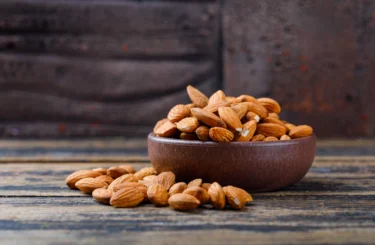
Almonds have very low amounts of calories. A 100 grams of almonds contains only 549 kcals1. Eating small amounts of almonds on a daily basis can provide your body with high levels of nutrients such as proteins, mono-saturated fats and antioxidants that are beneficial for overall health. Furthermore, almonds also improve your health by lowering bad cholesterol2, which tends to be high in people who are obese or overweight.
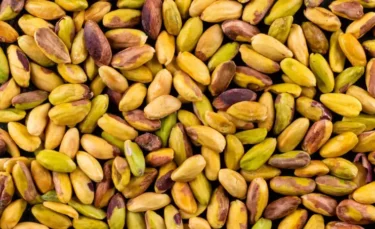
People who like to snack frequently can benefit a lot from eating pistachios. This is mainly because they have very high amounts of fibre, which helps your body feel full for longer periods of time3. Additionally, fibre is good for digestion as it aids with bowel movement.
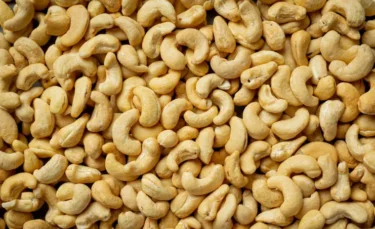
Cashews are delicious nuts that are quite popular in India. They are a very rich source of magnesium, which can be beneficial for weight loss because it helps regulate the fat and carbohydrate metabolism in the body.
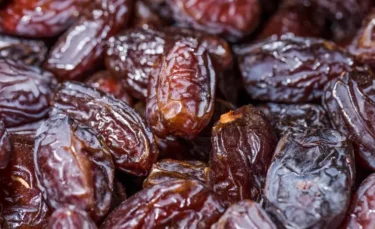
Dates are rich in flavour and good for weight loss. This is because they have high fibre content, which may help to suppress food cravings by making you feel full. As a result, you will be less prone to snacking between your meals.
Dates are also beneficial as they provide your body with Vitamin B5. This vitamin is known for boosting your stamina, which means that you can exercise for a longer period, and work towards getting your ideal weight!
In my experience, I have observed that the digestion process can actually enhance the health benefits of dried fruits. For example, when dried fruits like apricots, figs, and raisins are consumed, their antioxidant activities increase after undergoing gastric digestion. This means that the dried fruits can provide even more antioxidant protection for our cells, shielding our body from the damage caused by harmful free radicals and promoting overall health12.
Dr. Rajeev Singh, BAMS
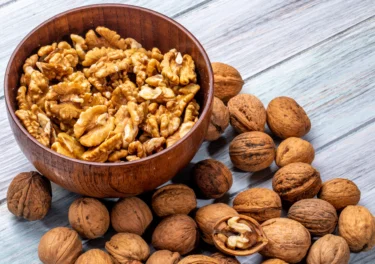
Walnuts are a great dry fruit as they contain high amounts of good fats such as omega 3 fatty acids and alpha-linolenic acid (ALA). Therefore, walnuts can help support your cardiovascular health and is also good for lowering body fat4. This can be a great addition to the diet as many people who are overweight are already at risk for cardiovascular problems and this can be a great way to try and prevent them.
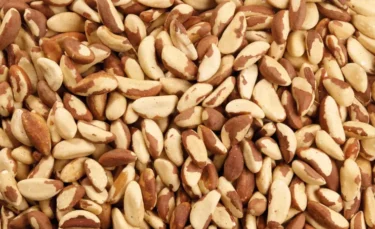
Brazil nuts have many properties that may aid weight loss. They contain an essential amino acid known as L-arginine, which can be helpful in burning fat. It increases body metabolism and thus, prevents the accumulation of unhealthy fat. Brazil nuts have high amounts of certain minerals such as selenium, thiamine, phosphorus and magnesium which can help maintain optimal cholesterol levels in blood and prevent damage to blood vessels5.
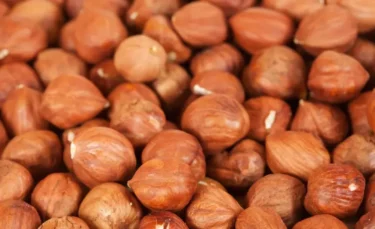
Hazelnuts have high fibre content as well as healthy fats, and both of these help with weight loss6. Like all the other high-fibre dry fruits mentioned in this article, hazelnuts also help in keeping you full for a longer time and controlling unhealthy snacking, which is often the first step in losing weight!

Apricots can stop you from feeling hungry for a long time after you eat them. Additionally, they provide your body with magnesium, which regulates fat metabolism. Apricots have a slightly sweet taste, and you can add them to certain desserts instead of sugar.
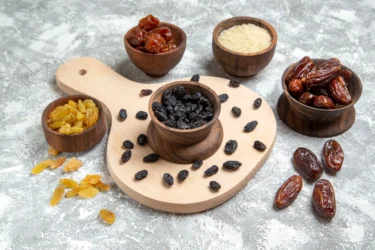
If you are looking for low-salt foods with weight loss properties , then it can be difficult to find suitable snacking options.. However, raisins offer both benefits! In 100 grams of raisins, you will find only 0.5 grams of fat and 299 kcal, making this a great snack for people who are trying to lose weight. They are proposed to help regulate cholesterol levels and may reduce hunger by influencing hormones responsible for satiety7.
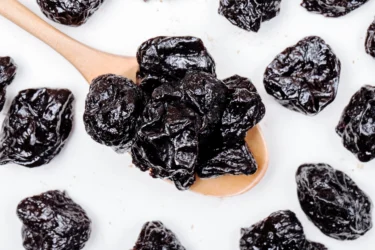
Prunes are also commonly called dried plums. They have high dietary fibre content, which promotes peristaltic movements in the intestines. As a result, waste and toxins get released from your body quickly and this can help you in losing weight. Additionally, 100 grams of prunes contains only 240 kcal, making this a good snack for people who need to control their daily calorie intake8.
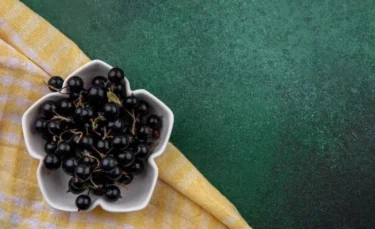
Black currant makes for a great pre-workout snack. It is easy to include in your diet and a versatile dry fruit like raisins. These dried fruits are high in nutrition and taste, making them a desirable snack. The dietary fibre and low sugar content. aids in weight loss. It also helps with other health issues like diabetes and heart disease due to its antioxidant properties9.
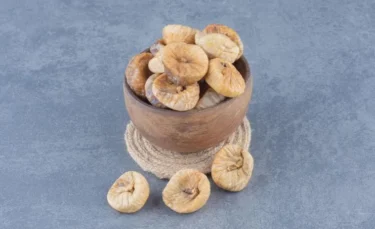
Dried figs are abundant in dietary fibres that aid the digestive system to function optimally. Figs also contain a digestive enzyme known as ficin. This enzyme helps you lose weight as it by improving lipid metabolism and reducing your craving for sugar. It also has a positive effect on gut microbes and helps fight oxidative stress10.
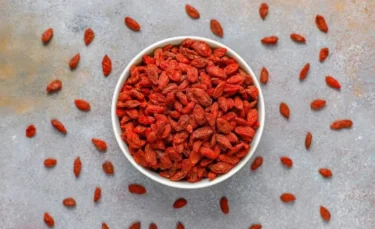
These tiny red berries are packed with nutrients and antioxidants. Goji berries have high fibre content and help increase the metabolism of your body. Drinking goji berry juice can boost metabolism and aid your weight loss journey11.
Over the years, I have observed that besides aiding in weight loss, dried fruits may also have a positive impact on reducing the risk of cardiovascular disease (CVD). While the consumption of dried fruits alone may not be significantly associated with cardiovascular mortality, when combined with fresh fruit intake, it has been found to lower the risk of CVD mortality. Therefore, incorporating a variety of dried and fresh fruits into your diet can help promote heart health and reduce the risk of cardiovascular issues12.
Dr. Smita Barode, BAMS, M.S.
Based on my experience, I have observed that incorporating dried fruits into your diet can be beneficial for your overall health. Dried fruits are a great source of dietary fiber, containing approximately 3.7 to 9.8 grams per 100 grams. By consuming around 20 to 30 grams of dried fruits per day, you can fulfill about 10 to 16% of your recommended daily fiber intake, which is around 14 grams12.
Dr. Siddharth Gupta, B.A.M.S, M.D (Ayu)
If you do not want to eat a bowl of raw nuts, you can consume them in other ways that are equally beneficial for you. For example:
Also Read: The Detailed 7 Days GM Diet Plan for Weight Loss
If you plan on adding dry fruits to your diet, here are a few other helpful tricks to speed up your weight loss:
Also Read: Ajwain: Uses, Benefits, Side Effects, and More!
Your health depends a lot on your weight as it can impact various body functions. Therefore, monitoring the same diligently can help you improve the way you look and feel. Ultimately, this can have many positive impacts on your life such as improved confidence and self-esteem, better social skills, more motivation and positive thoughts. Even if it may seem very difficult initially, you should know that if you take simple steps such as eliminating unhealthy food items and including weight loss foods like dry fruits in your diet can help you achieve your goals!
Also Read: 17 Health Benefits of Dates And Date Recipes
Dry fruits are healthy snacks to eat on the go. Dry fruits like almonds, apricots, prunes, figs and others mentioned above, can help reduce food cravings and avoid weight gain. However, to target fat on specific sites in the body, a regular fitness regimen is essential..
Soaking dry fruits helps replenish moisture and fortifying other nutrients present in them and seeds. It also ensures better digestion and enhances the flavour. Consuming soaked dry fruits regularly on an empty stomach in the morning can be good for health.
It is recommended that having 6-8 almonds each day is safe. Soaked almonds are beneficial, and it is best to consume them in the morning. However, you must avoid having fried and salted almonds.
Disclaimer: The information provided here is for educational/awareness purposes only and is not intended to be a substitute for medical treatment by a healthcare professional and should not be relied upon to diagnose or treat any medical condition. The reader should consult a registered medical practitioner to determine the appropriateness of the information and before consuming any medication. PharmEasy does not provide any guarantee or warranty (express or implied) regarding the accuracy, adequacy, completeness, legality, reliability or usefulness of the information; and disclaims any liability arising thereof.
Finger millet, commonly known as ragi, is a cereal grain widely eaten in South India and parts of Africa. It is often appreciated for its high fibre content and is naturally rich in calcium and iron, making it a valuable part of traditional diets.
Ragi is also commonly prepared as a porridge for infants in some regions, usually once they are a few weeks old and under proper guidance. Its smooth texture and mild taste make it a popular choice for early weaning foods in certain cultural practices1.
While ragi is sometimes included in diets focused on weight management or balanced blood sugar, it should be seen as part of an overall healthy eating plan. Anyone with specific health conditions, such as diabetes, should consult a healthcare professional for personalised advice.
Did you know?
Before the 1950s, whole grains such as ragi, brown rice, and barley were commonly grown using traditional farming methods and formed a significant part of regional diets in India. Over time, with the widespread adoption of polished white rice as a staple and lifestyle shifts brought on by urbanisation and the rise of the information technology sector, many people began relying more on processed and convenience foods.
As a result, there has been growing interest in returning to nutrient-rich whole grains like ragi, which are naturally high in fibre, calcium, and iron. Health professionals often recommend including such grains as part of a balanced diet. Unfortunately, ragi is less common in the diets of many teenagers today.
This article aims to highlight the potential long-term benefits of incorporating ragi into everyday meals as part of a healthy lifestyle.
Ragi contains a unique protein called eleusinian, which contributes to its nutritional value. It is often regarded as a good plant-based protein source, particularly for vegetarians. One of the amino acids present in ragi, methionine, makes up around 5% of its total protein content.
Ragi has been cultivated for centuries and is known for its ability to grow in high altitudes and survive in tough climatic conditions. Because the grain is so small, it is not polished like other cereals, which means it is usually consumed in a more natural, unprocessed form. This helps it retain more of its original nutrients, including complex carbohydrates2.
Ragi is naturally high in dietary fibre, which may help you feel fuller for longer and reduce the tendency to snack between meals. Because of this, it is often included in meal plans focused on healthy weight management.
It also contains an amino acid called tryptophan, which is thought to play a role in regulating appetite. Including ragi as part of a balanced breakfast is a common practice in many regions, as it can be both filling and nutritious3.
While ragi is sometimes recommended as part of a diet for managing blood sugar levels, it is not a substitute for medical treatment or insulin. Always consult a healthcare professional for personalised advice, especially if you have diabetes or other health conditions.
Ragi contains naturally occurring nutrients, including amino acids such as methionine and lysine. These nutrients, along with antioxidants found in the grain, are believed to support overall wellbeing and are sometimes linked to skin health when part of a balanced diet.
While ragi is not a treatment for skin conditions or ageing, a nutritious diet that includes whole grains may contribute to a healthy appearance over time. Its nutritional profile makes it a valued ingredient in many traditional diets4.
Ragi contains small amounts of Vitamin E, a nutrient that is known to support skin health as part of a balanced diet. Vitamin E contributes to maintaining the skin’s natural moisture and is often associated with helping the skin feel soft and well-nourished.
While it is not a medical treatment, including foods rich in vitamins, such as ragi can be a part of a healthy lifestyle that supports overall wellbeing.
Ragi is a source of plant-based protein, which plays an important role in overall nutrition. Since hair is largely made of a protein called keratin, consuming a balanced diet that includes adequate protein may support the body’s natural processes involved in hair growth5.
Ragi also contains nutrients such as magnesium and antioxidants, which are believed to contribute to general wellbeing. While ragi is not a remedy for hair loss or greying, maintaining good nutrition through whole grains like ragi can be part of a healthy lifestyle that supports the body’s functions, including those related to skin and hair.
Ragi is well known for being one of the richer plant-based sources of calcium among commonly consumed grains. Calcium is essential for the development and maintenance of healthy bones and teeth, and a balanced diet that includes calcium-rich foods can help support long-term bone health.
Approximately 100 grams of ragi contains around 350 milligrams of calcium, making it a valuable addition to vegetarian and plant-based diets6. Ragi porridge (commonly known as ragi kanji) is a traditional way to enjoy this grain, especially in parts of South India.
While dietary sources of calcium are important, individuals with specific health conditions—such as osteoporosis, should follow professional medical advice regarding supplementation or treatment.
Green ragi (sprouted finger millet) is traditionally included in the diets of many lactating women in parts of India. It is known to contain nutrients such as iron, calcium, and amino acids, which are important for overall maternal nutrition.
While a healthy diet can support a mother’s wellbeing during breastfeeding, it’s important to remember that dietary needs vary for each individual. Including nutrient-rich foods like green ragi may be beneficial as part of a balanced postnatal diet, but it should not be seen as a guaranteed way to influence breast milk production7.
Lactating women are encouraged to consult with a doctor or nutritionist to ensure they are meeting their nutritional needs for both themselves and their babies.
Ragi contains dietary fibre and natural compounds like polyphenols, which are often associated with slower digestion and a feeling of fullness. Compared to many other whole grains, ragi has a relatively high fibre content, which may help support steady energy levels throughout the day.
Some people include ragi in their meals as part of a diet aimed at maintaining balanced blood sugar levels. Its slower digestibility may contribute to prolonged satiety, which can be helpful in managing appetite8.
While ragi is considered a wholesome addition to a balanced diet, individuals with diabetes or related conditions should follow medical advice when planning their meals.
Ragi is a good source of dietary fibre, which plays an important role in supporting digestive regularity as part of a balanced diet. Fibre-rich foods like ragi may help promote smoother digestion and contribute to overall wellbeing.
Ragi is also versatile in the kitchen. From traditional dishes like ragi dosa and ragi balls (ragi mudde) to modern recipes like porridge or baked goods, it’s a wholesome grain that can be enjoyed in many delicious ways9.
Including ragi in your meals is one simple way to add variety and nutritional value to your diet.
In traditional food cultures, ragi is sometimes described as having a naturally cooling effect on the body, especially when consumed during the hot summer months. It is often included in meals for its light, wholesome qualities.
While ragi is not a treatment for mental health conditions such as anxiety, insomnia, or depression, including fibre-rich whole grains in your diet may support general wellbeing and help you feel nourished and satisfied10.
If you’re experiencing sleep disturbances or emotional stress, it’s important to speak with a qualified healthcare professional.
Ragi contains dietary fibre and natural plant compounds such as phytonutrients and lignans. These are studied for their potential roles in supporting digestive health and overall well-being when included as part of a balanced diet.
While some research has explored the relationship between fibre-rich diets and long-term health outcomes, ragi is not a treatment or preventive measure for cancer. Anyone concerned about their cancer risk should consult a qualified healthcare professional for personalised advice11.
Researchers1 have found that the rich antioxidant content of ragi may play a role in supporting tissue repair and wound healing.
Dr. Siddharth Gupta, B.A.M.S, M.D (Ayu)
While ragi offers notable nutritional value, its taste may be unfamiliar to those trying it for the first time. However, with regular inclusion in meals, many individuals become accustomed to its distinctive flavour. Given its versatility and composition, ragi can serve as a beneficial component of a balanced and varied diet when consumed as part of a healthy lifestyle.
Masala dosa is a much-loved dish across South Indian households. For those seeking to increase the nutritional value of their meals, ragi flour can be incorporated into the traditional dosa batter to prepare a variation known as ragi masala dosa. When served with potato curry, it offers a flavourful and satisfying breakfast option, combining taste with the benefits of whole grains.
Preparation Time: Approximately 35 minutes
Before you begin, ensure that you have the following ingredients ready:
How To Prepare Ragi Onion Masala Dosa
Preparation Time: Approximately 30 minutes
To prepare soft, flavourful, and healthy ragi idlis, ensure the following ingredients are assembled before beginning.
Ingredients of Ragi Idli
How To Prepare Ragi Idli
Also Read: 11 Incredible Health Benefits Of Fennel Seeds (Saunf)
Weight loss efforts often involve reducing sugar intake, which can be challenging for those with a sweet tooth. However, a nutritious alternative like ragi halwa allows you to satisfy occasional sweet cravings without compromising your health goals.
Ingredients of Ragi Halwa
How to Prepare Ragi Halwa
According to studies12, the phenolic content in ragi, particularly the tannins may help provide resistance against fungal infections. These compounds, concentrated in the outermost layer of the grain, act as a structural barrier to fungal invasion. Research indicates that acidic methanolic extracts from the ragi seed coat, which is rich in polyphenols, exhibit stronger antifungal and antibacterial activity compared to similar extracts from whole wheat.
Dr. Rajeev Singh, BAMS
While ragi is rich in essential nutrients and offers numerous health benefits, it should be consumed in moderation. Excessive intake may lead to an increase in oxalic acid levels in the body, which is not advisable for individuals with kidney stones. As part of a balanced diet, ragi can support overall wellbeing, but it should not become the sole focus of one’s nutritional habits.
Also Read: 12 Ways How Avocado (Butter Fruit) Can Benefit Your Overall Health And Skin
Incorporating ragi into your daily meals can offer a range of health benefits, from improved digestion to better bone health. Its rich nutritional profile makes it a valuable addition to a balanced diet. However, like any food, it should be consumed in moderation and tailored to individual health needs.
Also Read: 10 Best Foods For A Healthy Gut System
Yes, it is safe and beneficial to include ragi in your daily diet. Ragi is a nutritious whole grain rich in fibre, calcium, and iron. Its gluten-free nature and low glycaemic index makes it suitable for regular consumption supporting digestive health and overall well-being.
Individuals with a history of kidney stones or oxalate-related issues should limit their ragi intake due to its oxalate content. However, for those with gluten sensitivity or celiac disease, ragi is a safe option as it is gluten-free. Always seek personalised advice from a healthcare professional to assess if ragi is suitable for your specific health condition.
Yes, ragi is a valuable food for weight loss and diabetes management. Its high fibre content promotes a feeling of fullness, reducing overall calorie intake. The complex carbohydrates in ragi have a low glycaemic index, which helps in better blood sugar management, making it beneficial for individuals with diabetes.
Yes, ragi can be a beneficial addition to the diet during pregnancy. Its iron and calcium content supports the increased nutrient requirements during pregnancy, and the fibre may help in digestion. Pregnant women can include ragi in various forms, but it is advisable to consult a healthcare provider for personalised dietary recommendations.
Ragi is an excellent option for introducing solid foods to infants and toddlers. Its nutritional profile supports healthy growth and development. Ragi porridge or homemade ragi-based baby food can be introduced gradually to infants around six months of age, following the recommendations of paediatricians.
Disclaimer: The information provided here is for educational/awareness purposes only and is not intended to be a substitute for medical treatment by a healthcare professional and should not be relied upon to diagnose or treat any medical condition. The reader should consult a registered medical practitioner to determine the appropriateness of the information and before consuming any medication. PharmEasy does not provide any guarantee or warranty (express or implied) regarding the accuracy, adequacy, completeness, legality, reliability or usefulness of the information; and disclaims any liability arising thereof.
Many individuals frequently experiment with various diets to maintain an ideal body weight. For those who struggle with restrictive or complicated plans, simple, home-based dietary practices using commonly available ingredients may offer supportive benefits. These methods, when adopted sensibly and under guidance, can complement a healthy lifestyle without depending on expensive supplements or extreme regimens.
While achieving and maintaining a healthy weight is important for individuals who are overweight or obese, it is equally essential to ensure that the diet remains nutritionally balanced. Some diets excessively restrict macronutrients like fats and carbohydrates, which may adversely affect metabolism and overall physiological functions. A sustainable plan should aim for moderation rather than elimination, supporting long-term health goals
So, which diet should you follow? What home remedies can help you to control your weight? What are the best supplements for weight loss? Read on to find the answers –

Lemon and honey are widely used household ingredients and are often included in morning routines. A warm glass of lemon water with a small amount of honey may support hydration, aid digestion, and provide a refreshing start to the day. While these ingredients have traditional uses and some health benefits, there is limited scientific evidence to suggest that they directly lead to fat loss. However, when incorporated into a balanced diet and healthy lifestyle, they may support general well-being1.
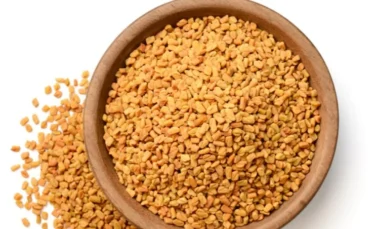
Many traditional Indian spices such as fenugreek seeds (methi), carom seeds (ajwain), and black cumin seeds (kali jeera) have been used in Ayurvedic and folk practices for digestive and metabolic support. Some preliminary studies suggest that these spices may help improve digestion and support metabolic health, which can indirectly aid in weight management. However, their role in directly reducing fat—especially in specific areas like the belly, is not conclusively proven.
A practical way to incorporate these spices is by dry roasting equal parts of fenugreek, carom, and black cumin seeds, grinding them into a fine powder, and consuming a small amount with warm water once daily. While this may help in improving digestion and metabolic support, sustainable weight loss primarily depends on balanced nutrition, physical activity, and overall lifestyle modifications.
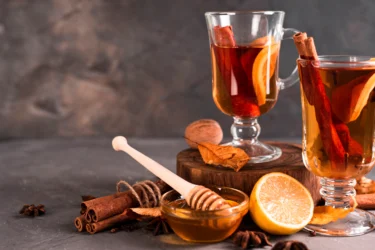
Cinnamon (Dalchini) is a commonly used spice in Indian cooking, known for its distinct aroma and flavor. Some studies suggest that cinnamon may help improve insulin sensitivity and reduce blood sugar spikes, which could indirectly support weight management. However, it should be considered a supportive addition rather than a standalone solution for weight loss2.
A traditional method to include cinnamon in your routine is by preparing a simple infusion. Warm a glass of water, add 1–2 small cinnamon sticks, and let it steep. Once lukewarm, add a teaspoon of honey, mix, and strain. Consuming this on an empty stomach may offer digestive and metabolic support. However, this should complement a healthy diet and lifestyle, not replace them.
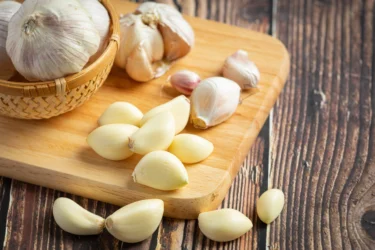
Garlic, a common kitchen ingredient, is well-known for its antimicrobial and anti-inflammatory properties. Some traditional practices suggest that consuming 1–2 raw cloves of garlic in the morning may support metabolism and overall health, which could indirectly aid in weight management. Although the strong flavor and smell may be challenging at first, regular use can become tolerable over time. It’s advisable to rinse your mouth afterward to reduce lingering odour3.

The sugars naturally found in fruits and vegetables are generally healthier than added or refined sugars. If your goal is weight loss, it is advisable to minimise your intake of processed sugars found in sweets, ice creams, and sugary beverages. Instead, focus on whole fruits and vegetables to satisfy your sweet cravings, as they come with the added benefit of fiber, vitamins, and minerals.
For example, vegetables like onions release a mild natural sweetness when sautéed slowly. This can enhance the flavour of your dishes without needing to add refined sugar. Similarly, carrots and certain types of pumpkin also contain naturally occurring sugars that contribute to a subtle sweetness. Using these ingredients creatively can help reduce your reliance on added sugars in cooking.

Drinking an adequate amount of water each day is a simple yet important factor in supporting healthy weight management. Many people do not consume enough water because they may not be aware of the recommended amounts or only drink when they feel thirsty4.

Getting adequate sleep is more of a lifestyle choice than a home remedy, but it is a simple and important step that everyone can adopt with some effort. Despite busy schedules and competing priorities, aim for at least 8 hours of sleep each night. Adequate sleep is as essential as maintaining a balanced diet for effective weight management5.
Sleep plays a critical role in regulating bodily functions, including hormone balance and digestive health. It helps maintain a healthy metabolic rate, which is important for reducing excess body fat and supporting overall weight loss.

Psychological factors play a significant role in shaping our lifestyle choices, including eating habits. The way our brain perceives our environment affects how much food we consume. For example, the size of the plate can influence portion size using a large plate may increase the risk of overeating.
This occurs because the brain associates plate size with the amount of food required. Larger plates tend to encourage larger portions, while smaller plates promote smaller servings. Eating from a smaller plate may help you feel satisfied with less food. Therefore, switching to a smaller plate can be a simple and effective strategy to support weight management6.

This eating pattern has been supported by research globally. Instead of consuming three large meals, breakfast, lunch, and dinner, try eating smaller, lighter meals every 3 to 4 hours. Consuming six lighter meals throughout the day helps prevent your stomach from being empty for long periods, which can support better digestion and energy levels7.
Eating frequent smaller meals can help prevent overeating. Long gaps between meals, such as between breakfast and lunch, can lead to excessive hunger and result in consuming larger portions. Having a small snack between meals reduces hunger and makes it easier to control portion sizes during main meals.
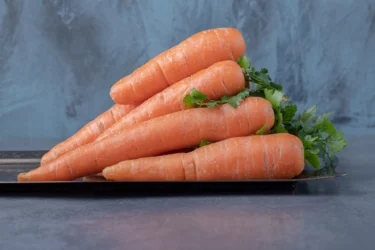
Meat, chicken and poultry should always be consumed only after proper cooking. However, some vegetables such as tomatoes, lettuce, spinach, carrots, and corn provide added nutritional benefits when eaten raw. Consider making a salad with these vegetables daily. Raw vegetables are an excellent source of fibre, which promotes healthy digestion. Efficient digestion is essential for the breakdown of fats and supports weight loss.
When consuming raw vegetables, it is advisable to choose organically grown produce whenever possible. Organic vegetables are free from insecticides and pesticides, which can be harmful when ingested raw. Incorporating raw organic vegetables into your diet is an effective natural strategy to support weight loss. Always ensure vegetables are thoroughly washed before consumption.
Also Read: Effective Home Remedies for Lice Removal

Proper chewing is essential for good digestion and helps prevent overeating. Studies show that people who eat slowly and chew their food thoroughly tend to consume fewer calories compared to those who eat quickly without chewing properly9.
Chewing breaks down food into smaller pieces and mixes it with saliva, which helps initiate digestion. When food is not chewed properly, the stomach takes longer to digest it, which may contribute to digestive problems and potential weight gain.
Additionally, eating slowly increases the likelihood of feeling full after consuming smaller portions.
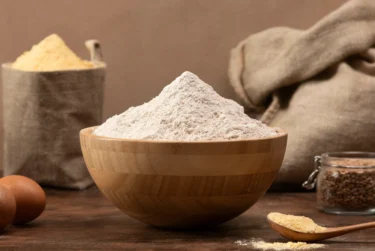
Grains are a staple food in India, consumed daily either in whole form or as flours. Whole grains offer the most health benefits. In contrast, refined grains or flours like maida are less healthy and may contribute to weight gain because they consist mainly of simple carbohydrates10. This is because the refined flours are made out of simple carbohydrates.
Whole grain flour (atta) is more beneficial as it contains a good amount of fibre along with carbohydrates. This fibre supports healthy digestion and bowel regularity. For rice, it is better to choose brown rice over white rice for the same reasons.

While this is not strictly a home remedy, quitting smoking is an important step if you want to lose weight. Smoking negatively impacts your health and can hinder your efforts to reduce excess weight. To support your weight loss and overall health, consider quitting smoking11.
Nicotine and other chemicals in cigarettes harm your body and can reduce your motivation and ability to exercise regularly. Quitting smoking can improve your overall health and make it easier to adopt an active lifestyle. Try to replace smoking with healthy habits such as a morning walk or jog.

Stress and tension are common in today’s fast-paced world, where many people juggle multiple responsibilities. While work and income are important, it is equally essential to take time to enjoy life’s simple pleasures. Studies show that individuals experiencing high stress levels may find it harder to lose weight compared to those who are more relaxed.
One effective approach is to practice meditation and breathing exercises regularly. These techniques can promote relaxation and support your weight management efforts. Breathing exercises also improve oxygen intake, which can enhance overall well-being12.
Another effective way to reduce stress is to plan family outings or vacations. Taking regular breaks throughout the year can help you feel rejuvenated and improve your overall happiness.
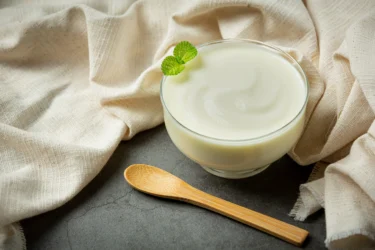
Yoghurt, a common ingredient in Indian kitchens, can be homemade or purchased from stores. It is most beneficial when consumed plain, without added sugar or flavoring. Made by fermenting milk, yoghurt contains beneficial probiotics that support gut health, along with essential nutrients found in milk13.
Yoghurt can be eaten on its own or used as a dressing for salads. It promotes the growth of healthy gut bacteria, which aid digestion. Additionally, yoghurt helps increase feelings of fullness, supporting appetite control without adding excessive calories.
In my experience of all the remedies for weight loss, Intermittent fasting for 16 hrs a day often gives good results in people who are otherwise healthy. But people with underlying conditions like diabetes, heart disease and kidney disease should not try fasting without consulting their doctor.
Dr. M.G. Kartheeka, MBBS, MD(Pediatrics)

Natural fruit and vegetable juices can be a helpful way to meet your body’s nutritional needs without consuming excessive calories. These beverages are typically low in added sugars and fats, which may assist in managing your overall intake of high-calorie foods. It is important to note, however, that while such drinks are often marketed as ‘juice cleanses for weight loss’, they do not cleanse the body in a medical sense. Rather, their benefits are generally linked to reduced calorie intake and the provision of essential vitamins and minerals, which may be especially useful when following a calorie-controlled diet14.

Crash diets are extreme eating plans that often involve prolonged fasting or the exclusive consumption of fruit juices. Such approaches can be harmful, as they may lead the body to break down muscle tissue in addition to fat. Moreover, research suggests that any weight loss achieved through these methods is frequently temporary, with individuals often regaining the lost weight over time. As a result, these diets typically do not offer sustainable or long-term health benefits15.
Rather than following extreme diets, it is advisable to consume regular meals prepared with minimal oil, sugar, and salt. Incorporate a variety of vegetables and fruits into your daily routine, along with sources of protein such as eggs, poultry, or lean meats. Adopting and maintaining this kind of balanced eating pattern, alongside a healthy lifestyle, can support overall well-being and may contribute to gradual and sustainable weight management.
Consider trying these home-based suggestions and take note of how they work for you. If adopting all of them at once feels overwhelming, begin with just a few and focus on gradually integrating them into your daily routine. Consistent, steady efforts often lead to meaningful and lasting results. To make the process easier, establish a simple daily schedule that accommodates these practices without demanding too much of your time. As these tips are intended to be practical and manageable, they should fit well even within a busy lifestyle.
Also Read: Ajwain: Uses, Benefits, Side Effects, and More!
The most effective way to manage weight at home involves a combination of a calorie-controlled diet, regular physical activity, and adequate sleep. The suggestions provided throughout this article are intended to support this holistic approach. When implemented consistently, these practices can contribute to improved overall health and gradual, sustainable weight management.
Yes, a protein-rich diet would be low in fats and would contribute to increased muscle mass and fat reduction. Individuals can have a protein-rich diet to lose weight (by reducing fat consumption) and to gain weight (by increasing muscle mass).
Rapid weight loss is generally not advisable, as it often involves extreme dietary practices such as prolonged fasting or the elimination of essential macronutrients. These methods can be detrimental to your overall health and may not result in sustainable weight loss. In many cases, any weight lost through such approaches is quickly regained once the restrictive diet is discontinued. A gradual, balanced approach is far more beneficial in the long term.
Disclaimer: The information provided here is for educational/awareness purposes only and is not intended to be a substitute for medical treatment by a healthcare professional and should not be relied upon to diagnose or treat any medical condition. The reader should consult a registered medical practitioner to determine the appropriateness of the information and before consuming any medication. PharmEasy does not provide any guarantee or warranty (express or implied) regarding the accuracy, adequacy, completeness, legality, reliability or usefulness of the information; and disclaims any liability arising thereof.
Regular physical activity is a vital component of maintaining overall health. Exercise contributes not only to weight management but also supports cardiovascular health, bone strength, mood regulation, and general wellbeing.
It is important to understand that both exercise and diet work together to support sustainable weight management. If one is prioritised while the other is neglected for example, exercising regularly without dietary changes, or following a diet without physical activity the body’s response may vary. This could lead to slower progress, fatigue, or changes in metabolism1.
Additionally, other factors such as sleep quality, stress levels, certain medical conditions (e.g., hypothyroidism, polycystic ovary syndrome), and medications can influence how the body responds to efforts aimed at weight loss.
For individuals diagnosed with conditions such as diabetes, incorporating exercises for diabetes which are appropriate to their health status can be beneficial. However, any exercise regimen should be discussed with a healthcare provider to ensure safety and effectiveness.
Here, we outline seven effective and popular exercise programmes that can be practised at home, helping you improve strength, fitness, and overall wellbeing, without the need for gym access or specialised equipment.
For those aiming to manage their weight, a combination of cardiovascular activity and resistance training, performed consistently, may offer benefits when paired with a balanced, calorie-conscious diet. Incorporating resistance training at least twice a week may help maintain muscle mass during weight loss.
Some research has explored whether the timing of exercise, such as working out in the morning affects weight loss or muscle development2. Cortisol, a hormone that follows a natural daily rhythm, typically peaks in the early morning. However, its effects are complex. Elevated cortisol levels under stress can sometimes contribute to muscle breakdown and fat retention. Current evidence does not conclusively support a “best” time of day for exercise that applies to everyone.


Walking is widely regarded as an accessible and low-impact form of cardiovascular exercise. When performed at a brisk pace, it can support calorie expenditure and be easily integrated into daily routines. It is also gentle on the joints, making it suitable for individuals across a wide range of fitness levels.
Some observational studies have noted that individuals who walk for 50–70 minutes, three times per week, may experience modest reductions in body fat and waist circumference over time. However, results can vary depending on individual factors such as diet, metabolism, and overall activity levels.
Jogging and running are more vigorous forms of aerobic exercise and involve higher levels of intensity. These activities primarily engage the lower body and cardiovascular system, and they may contribute to improved endurance, heart health, and calorie expenditure. The key distinction between jogging and running lies in the pace, jogging typically ranges from 6–9 km/h, while running generally starts from around 10 km/h.
On average, a person may burn approximately 298 calories in 30 minutes of jogging and 372 calories in 30 minutes of running, though actual figures depend on body weight, intensity, and terrain. While these exercises can assist in reducing overall body fat, it is important to note that fat loss from specific areas, such as the abdomen cannot be targeted directly and depends on total fat reduction and individual physiology3.
Although jogging and running can help maintain muscle tone, especially in the lower body, significant gains in muscular strength typically require resistance training or structured strength-based workouts.
Exercise Pattern
Set aside 1 hour of your time and include these exercises in your routine.

While skipping can assist with muscle toning and calorie expenditure, significant muscle strength gains require dedicated resistance training. It may also support mood and stress management, but it is not a substitute for professional mental health care4.
As with any exercise, individual results may vary depending on fitness level, diet, and consistency.
Exercise Pattern

The plank is a core stabilisation exercise that targets multiple muscle groups including the abdominals, shoulders, back, chest, and hips. Though it appears simple, it requires muscular endurance and can be physically demanding when performed correctly.
Planks help improve core strength, posture, and body balance, and come in various forms to target different muscle areas. While not designed for high calorie burn or direct fat loss, planks are valuable for enhancing overall stability and muscular endurance5.
Increasing the duration and consistency of plank practice may lead to better functional strength and support in other forms of exercise.
Plank Exercise Variations
Exercise Pattern
The Reverse Plank: This exercise is a variation of the standard plank, performed in a reversed position. It is an excellent way to stretch the body while also helping to reduce excess fat and calories. Additionally, this workout strengthens the core, shoulders, back, chest, and gluteal muscles.
Exercise Pattern

Push-ups are a widely practised bodyweight strength exercise that require no equipment and can be performed virtually anywhere. They primarily target the chest, triceps, shoulders, and core, helping to build upper body strength and muscular endurance.
While push-ups do not burn as many calories as aerobic exercises, they contribute to muscle development, which may support long-term weight management by modestly increasing resting metabolic rate6.
Regular push-up training can improve overall physical stability and strength, particularly when combined with other forms of exercise such as cardio or resistance training.
Exercise Pattern
Push-ups are a widely practised bodyweight strength exercise that require no equipment and can be performed anywhere. They primarily target the chest, triceps, shoulders, and core, contributing to the development of upper body strength and enhancing muscular endurance.
While push-ups do not burn as many calories as aerobic exercises, they contribute to muscle development, which may support long-term weight management by modestly increasing resting metabolic rate.
Regular push-up training can improve overall physical stability and strength, particularly when combined with other forms of exercise such as cardio or resistance training.
Exercise Pattern

Squats are a lower-body strength exercise that primarily target the thighs, hips, and glutes. They help improve mobility, balance, and muscular endurance, making them a fundamental part of many fitness routines.
While squats may contribute to calorie expenditure and muscle toning, their main benefit lies in strengthening the lower body. Beginners are often advised to start with 3 sets of 12–15 repetitions, focusing on proper form to avoid injury and maximise effectiveness7.
Exercise Pattern:

Lunges are a lower-body strength training exercise that primarily target the quadriceps, glutes, hamstrings, and engage the core for stability. They are effective for building lean muscle, improving balance, coordination, and lower body endurance.
While lunges can be part of a fat-loss programme when included in a high-intensity routine, their primary role is in toning and strengthening. Using added weights can further enhance their effectiveness, especially for athletic training and improved overall fitness8.
Exercise Pattern
Along with exercises that need to be done at your place for weight loss. There are other factors and methods that can be helpful for weight management.

Yoga is an ancient practice that integrates physical postures, controlled breathing, mindfulness, and relaxation. When combined with healthy eating and regular activity, yoga may support weight management, improve mental wellbeing, and enhance body awareness9.
While not primarily focused on calorie burning, yoga promotes stress reduction, which can positively influence lifestyle habits. Some forms of yoga may also support flexibility, balance, and metabolic health such as yoga for diabetes, making it a valuable addition to a holistic wellness routine.
Along with supporting weight management, yoga offers a range of additional benefits, including:
Specific yoga poses play a supportive role in weight management by enhancing muscle tone, balance, and concentration. Regular practice helps the body adapt to these movements, allowing you to gradually improve strength, flexibility, and mind-body awareness, all of which contribute to overall well-being and fitness.
Some of the yoga poses that should be practiced for weight loss are:
Below is a general guide to the approximate number of calories burned during various exercises, based on moderate intensity. Actual values can vary depending on factors such as body weight, age, fitness level, workout intensity, and duration:
While many prefer to exercise in the morning, especially on an empty stomach, believing it may support fat metabolism, the most important factor is consistency. Morning workouts can help align your circadian rhythm, supporting better sleep and routine adherence over time.
Some studies suggest evening workouts may improve performance due to increased body temperature and oxygen efficiency. However, research remains inconclusive. Ultimately, the best time to exercise is the time that suits your schedule and lifestyle, allowing you to remain active regularly and sustainably.
Follow these tips to make sure your weight loss programme at home is done properly:
Also Read: Benefits of Doing the Plank Exercise Every Day
No, weight loss is a combination of regular workouts and a proper diet. It is important to ensure to follow both to achieve the desired results.
No, sweating is your body’s natural way of regulating temperature. As your internal temperature rises, your body releases sweat, which cools the skin through evaporation. It is a sign of thermoregulation, not necessarily an indicator of calorie burn or workout intensity.
To improve fitness and maintain good health, it is advisable to exercise at least 2–3 times per week consistently, rather than sporadically. Regular workouts yield better long-term results.
A general way to estimate daily calorie intake for weight maintenance is to multiply your ideal body weight (in pounds) by 14. For example, if your ideal weight is 135 pounds, you may need around 1,890 calories per day (135 × 14).
Some initial weight loss in a week is possible through regular exercise, mindful eating, and increased activity. However, early changes are often due to water loss, not fat. For safe and lasting results, aim for 0.5 to 1 kg per week through a balanced diet, moderate calorie deficit, and consistent physical activity.
Weight loss occurs when you burn more calories than you consume. While reducing calorie intake can lead to a calorie deficit, completely avoiding food is not a healthy approach. The body may slow its metabolism and trigger energy conservation, making weight loss harder over time. It’s essential to eat balanced, nutritious meals to support both health and sustainable weight loss.
Any foods with high carbohydrates and fats should be avoided if you want to lose weight. These include french fries, potato chips, white bread, pastries, cookies and sugary drinks.
Disclaimer: The information provided here is for educational/awareness purposes only and is not intended to be a substitute for medical treatment by a healthcare professional and should not be relied upon to diagnose or treat any medical condition. The reader should consult a registered medical practitioner to determine the appropriateness of the information and before consuming any medication. PharmEasy does not provide any guarantee or warranty (express or implied) regarding the accuracy, adequacy, completeness, legality, reliability or usefulness of the information; and disclaims any liability arising thereof.